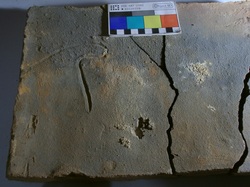
I have been asked to supply some slides for a public lecture based on some of my thoughts on the work I did in Sagalassos last summer.
One of the things that struck me about the assemblage was the range and complexity of the signatures compared to the sites that I usually deal with. There are a number of caveats of course – the material I was looking at was from over a decade’s worth of excavation and only the most complete examples were present. Normally I only have fragment of signatures to deal with - but sometimes I get interesting complete examples, such as this example from a site in Cambridgeshire, which is alos noted at Piddington villa
P signature from Turners hall farm , Cambridgeshire ( work commissioned by Hereford Archaeological Trust)
Normally a signature is found on tegula and has been made using a finger or a stick by the tile maker at the end of the shaping process and when the tile is left for primary drying. Looking at Shawn Grahams Ex Figlinis I find they must be related to Anepigraphic stamps - in as much that there is a small range of signatures commonly repeated – so it is a device which has meaning in a specific place and for a short time, of which the most obvious is to identify the tiles made by a specific tile maker when it goes into the kiln ( where several tile makers use the same kiln), Or to identify the fired tiles of a specific tile maker. Normally less than 0.1% of the assemblage appears to have any traces of a signature – although I will have to go through my database and check so that I can get proper figures by form type and fabric, so about 1 tie in every 1000 is marked in this way – which nicely agrees with the proportion of relief pattern tiles I found in Leicester shire hall – so we are looking at say one tile in 1000 marked in this way. One can imagine that tiles are stacked in a kiln to allow batches to be easily differentiated, although I can imagine the logistics could be fraught id more than a couple of tilemakers are using the same kiln, This may explain ( in addition to sampling error) why I have some groups with high signature rates – where kiln design or capacity meant that tile makers had to sign a lot more of their products in order to reclaim the right ones after firing.
Currently I have no numbers for the levels of signed tiles at Sagalassos , but the variation in designs are interesting, as well as the relationship to other markings ( stamps in particular) all suggest a complex economic sector which is organised somewhat differently than those in Britain, Italy or the Levant.

 RSS Feed
RSS Feed
